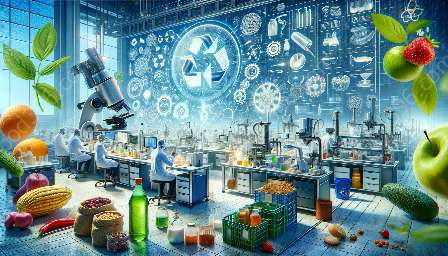Food waste is a significant global challenge that has both environmental and economic impacts. According to the Food and Agriculture Organization of the United Nations, approximately one-third of all food produced for human consumption is lost or wasted every year. This staggering amount of waste not only contributes to greenhouse gas emissions but also represents a lost opportunity for addressing food insecurity and poverty.
As a result, the management of food waste has become a critical area of focus for sustainability efforts worldwide. Recycling and recovering food waste through various methods play a crucial role in minimizing its adverse effects. This article explores the different food waste recycling and recovery methods, their compatibility with food waste management, and their relation to food science and technology.
Composting
Composting is a natural biological process that decomposes organic materials such as food scraps and yard waste into a nutrient-rich soil amendment known as compost. This method involves the decomposition of organic matter by microorganisms such as bacteria, fungi, and actinomycetes, which break down the waste into simpler organic compounds. Composting not only diverts food waste from landfills but also produces a valuable end product that can improve soil health and fertility.
Food waste management practices often integrate composting as a sustainable solution for organic waste. In the context of food science and technology, composting contributes to the circular economy by closing the loop on nutrient cycling and promoting sustainable agriculture. Research in this field focuses on optimizing the composting process, exploring the use of compost in food production, and assessing its impact on food quality and safety.
Anaerobic Digestion
Anaerobic digestion is another effective method for recycling and recovering food waste. This process involves the breakdown of organic materials in the absence of oxygen, resulting in the production of biogas and digestate. Biogas, primarily composed of methane and carbon dioxide, can be utilized as a renewable energy source for heat and electricity generation. Digestate, the nutrient-rich byproduct of anaerobic digestion, can be used as a natural fertilizer in agriculture.
Food waste management systems often incorporate anaerobic digestion to harness sustainable energy and nutrient recovery. From a food science and technology perspective, anaerobic digestion aligns with the trend of bioenergy production and resource efficiency. Ongoing research explores the optimization of anaerobic digestion processes, the utilization of biogas in food processing, and the development of innovative applications for digestate in sustainable crop production.
Upcycling and Repurposing
Upcycling and repurposing food waste involve transforming leftover or surplus food into new products with added value. This approach aims to minimize waste generation and create marketable goods from food items that would otherwise be discarded. Examples of upcycling food waste include turning fruit and vegetable peels into snacks, using surplus bread for brewing beer, and converting food scraps into animal feed or bioplastics.
Food waste management strategies increasingly emphasize upcycling and repurposing as innovative ways to prevent waste and promote sustainable consumption. In the realm of food science and technology, upcycling aligns with the principles of waste reduction, resource efficiency, and product innovation. Research in this area focuses on developing novel food products from upcycled ingredients, optimizing food waste utilization in manufacturing processes, and evaluating the sensory and nutritional attributes of upcycled foods.
Food Waste-to-Energy Technologies
Food waste-to-energy technologies encompass a range of innovative approaches that convert food waste into renewable energy sources such as biogas, biofuels, or electricity. These technologies include thermal processes like pyrolysis and gasification, as well as biochemical processes such as microbial fuel cells and enzymatic conversion. By extracting energy from food waste, these methods contribute to the efficient utilization of organic resources while reducing reliance on fossil fuels.
Food waste management initiatives increasingly explore the implementation of waste-to-energy technologies to diversify energy portfolios and reduce environmental impacts. From a food science and technology standpoint, these innovations align with the pursuit of sustainable energy solutions, resource valorization, and environmental stewardship. Ongoing research focuses on improving the efficiency and scalability of food waste-to-energy processes, exploring novel conversion pathways, and assessing the environmental sustainability and life cycle impacts of these technologies.
Waste Reduction and Source Separation
Waste reduction and source separation practices play a fundamental role in preventing food waste and facilitating effective recycling and recovery. By implementing strategies such as portion control, meal planning, and proper storage techniques, households, food service establishments, and food production facilities can minimize the generation of food waste. Source separation, which involves sorting and segregating different types of waste at the point of generation, enables targeted recycling and recovery efforts.
The integration of waste reduction and source separation strategies into food waste management aligns with the principles of sustainable consumption and production. From a food science and technology perspective, these practices link to efforts aimed at optimizing food packaging, extending shelf life, and reducing post-harvest losses. Research in this area encompasses consumer behavior studies, packaging innovation, supply chain optimization, and sustainable food system management.
Conclusion
Food waste recycling and recovery methods play a critical role in addressing the complex challenges associated with food waste management. By integrating sustainable practices such as composting, anaerobic digestion, upcycling, waste-to-energy technologies, and waste reduction strategies, stakeholders across the food supply chain can minimize waste generation, recover valuable resources, and contribute to environmental conservation. From a food science and technology perspective, ongoing research and innovation in this field are essential for advancing sustainable food production, resource utilization, and waste management practices.
By understanding the diverse methods for recycling and recovering food waste, individuals, businesses, and policymakers can make informed decisions to support a more sustainable and resilient food system. Through collaborative efforts and technological advancements, the journey towards a circular economy for food waste becomes attainable, offering promising solutions for the future of food sustainability and security.

